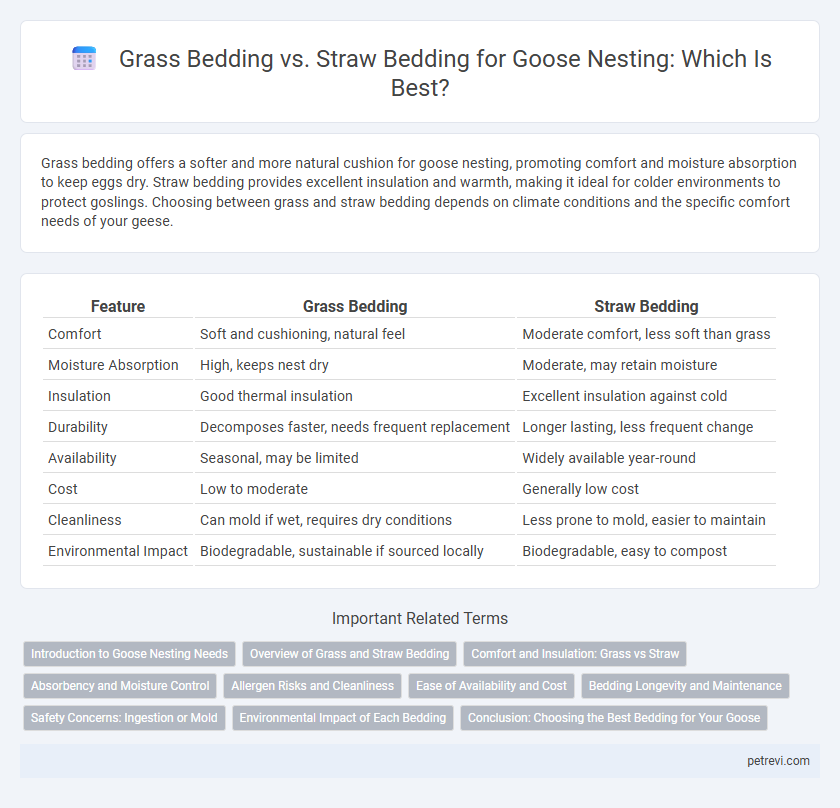Grass bedding offers a softer and more natural cushion for goose nesting, promoting comfort and moisture absorption to keep eggs dry. Straw bedding provides excellent insulation and warmth, making it ideal for colder environments to protect goslings. Choosing between grass and straw bedding depends on climate conditions and the specific comfort needs of your geese.
Table of Comparison
| Feature | Grass Bedding | Straw Bedding |
|---|---|---|
| Comfort | Soft and cushioning, natural feel | Moderate comfort, less soft than grass |
| Moisture Absorption | High, keeps nest dry | Moderate, may retain moisture |
| Insulation | Good thermal insulation | Excellent insulation against cold |
| Durability | Decomposes faster, needs frequent replacement | Longer lasting, less frequent change |
| Availability | Seasonal, may be limited | Widely available year-round |
| Cost | Low to moderate | Generally low cost |
| Cleanliness | Can mold if wet, requires dry conditions | Less prone to mold, easier to maintain |
| Environmental Impact | Biodegradable, sustainable if sourced locally | Biodegradable, easy to compost |
Introduction to Goose Nesting Needs
Goose nesting requires bedding that offers insulation, comfort, and moisture control to ensure egg safety and encourage hens to settle. Grass bedding provides softness and effective moisture absorption, creating a breathable environment that helps regulate temperature and reduce mold risk. Straw bedding, while more traditional, offers better structural support for nests but can retain moisture longer, potentially increasing the risk of damp conditions that affect egg viability.
Overview of Grass and Straw Bedding
Grass bedding offers soft, moisture-absorbent qualities that enhance comfort and reduce ammonia buildup in goose nesting areas. Straw bedding provides excellent insulation and durability, maintaining warmth and structure throughout the nesting period. Both materials contribute to nest hygiene but differ in texture and biodegradability, impacting overall goose health and nesting success.
Comfort and Insulation: Grass vs Straw
Grass bedding offers superior moisture absorption and softness, enhancing comfort for geese during nesting by reducing dampness and providing a cushioning effect. Straw bedding excels in insulation, trapping air effectively to maintain warmth, which is crucial for egg incubation and gosling development. Choosing between grass and straw depends on balancing the need for moisture control with optimal thermal insulation in the nesting environment.
Absorbency and Moisture Control
Grass bedding typically offers moderate absorbency, helping to manage moisture in goose nesting areas effectively and reducing the risk of dampness that can harm eggs. Straw bedding provides superior moisture control due to its coarse structure, allowing better air circulation and quicker drying, which promotes a healthier environment for goslings. Choosing straw over grass bedding can significantly enhance nest dryness and minimize bacterial growth from excess moisture.
Allergen Risks and Cleanliness
Grass bedding for goose nesting offers a natural, breathable environment that reduces allergen buildup compared to straw, which tends to trap dust and mold spores. Straw bedding can harbor mites and fungi, increasing allergen risks and requiring frequent replacement to maintain cleanliness. Regularly changing grass bedding helps control ammonia levels and moisture, promoting healthier nesting conditions and minimizing respiratory issues in geese.
Ease of Availability and Cost
Grass bedding for goose nesting offers high ease of availability in regions with abundant natural meadows, often at minimal or no cost when harvested locally. Straw bedding, commonly sourced as a byproduct of cereal crops, is widely accessible through agricultural suppliers but may incur moderate purchasing expenses. Cost-effectiveness depends on local resource abundance, with grass bedding generally favored for low-cost, eco-friendly nesting material and straw preferred for consistency and insulation qualities.
Bedding Longevity and Maintenance
Grass bedding for goose nesting provides moderate longevity but requires frequent replacement due to quicker decomposition and moisture retention, which can lead to mold growth. Straw bedding offers extended durability and better insulation, reducing the need for regular maintenance while providing a dry, comfortable environment that supports egg incubation. Effective bedding choice enhances nest sanitation and promotes healthy gosling development by minimizing dampness and bacterial buildup.
Safety Concerns: Ingestion or Mold
Grass bedding for goose nesting offers higher moisture retention, increasing the risk of mold growth that can lead to respiratory issues and poisoning if ingested. Straw bedding tends to be drier, reducing mold development and minimizing the chances of harmful ingestion, thus promoting safer nesting conditions. Monitoring bedding cleanliness and replacing damp materials regularly help mitigate safety concerns associated with both options.
Environmental Impact of Each Bedding
Grass bedding for goose nesting offers a biodegradable option that decomposes faster, reducing landfill waste and promoting soil health through nutrient recycling. Straw bedding, while also biodegradable, often requires more intensive agricultural resources to produce, leading to a larger carbon footprint and potential pesticide residues. Choosing grass bedding supports sustainable nesting environments by minimizing chemical inputs and enhancing local ecosystem balance.
Conclusion: Choosing the Best Bedding for Your Goose
Grass bedding offers superior moisture absorption and natural cushioning, promoting healthier and cleaner nesting environments for geese. Straw bedding, while providing better insulation during colder months, can retain more moisture, potentially increasing the risk of bacterial growth in nests. For optimal goose nesting, selecting bedding depends on climate conditions and moisture management, with grass bedding generally preferred for its hygienic benefits and straw favored in colder climates for warmth.
Grass bedding vs Straw bedding for Goose Nesting Infographic

 petrevi.com
petrevi.com